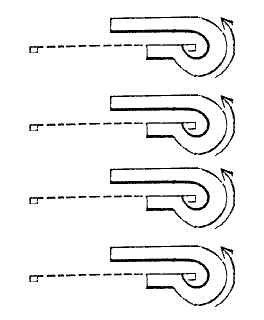
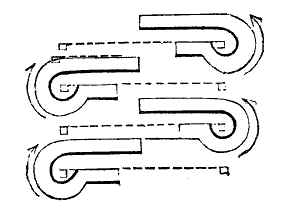
(1) What's with Doing Things "By File" in Closed Ranks?
(A) By file, right (or left) - DRESS
Many commanders preface their commands with the term, "by file." One such command is "by file, right (or left) - DRESS." Some basis for this command actually exists in the school of the company. Unfortunately, this command is applied to new soldiers in open ranks who are learning the basics of company alignments. H.C. 19 and C.C. 19. It is not a command for companies in closed ranks. Use the command, "right (or left) DRESS" as written in the manuals.
(B) March or Dress?
A similar command is: "right (or left) dress - MARCH." There is no such command in any manual.
The command to move troops in a new direction such as forward or backward is, "march," as in "forward - MARCH" or "backward - MARCH." When troops need to dress to a side, the command is, "right (or left) - DRESS."
Even more dastardly is "by files, right (or left) dress - MARCH." As already noted, "by file" not a prepatory command for troops in closed ranks. "March" is not a command of execution when dressing. The execution is the simple, one syllable word, "dress."
(C) By file, right - FACE.
Another "file" command is: "By file, right - FACE." The intent of the command is for the men to face right in two ranks instead of doubling into fours. There is no such command in any manual.
There is no explicit command in Revised Hardee's or Casey's for the men to remain in two ranks after facing. An unspecified warning is all either manual requires. See, Revised Hardee, SoS 373-374; Casey, SoS 386-87. However, Gilham's contains a specific command for remaining in two ranks while facing. It is, "in two ranks, right (left) FACE." See, para. 237 of Gilham's.
"Without doubling" is another alternative perpatory command found in an obscure Michigan manual. Although its use would be acceptable, use of the specific command, "in two ranks" from the commonly used Gilham's - seems more appropriate than use of a command from an uncommon manual.
(D) 1. Fire by files from the right 2. Commence - FIRE.
This reenactorism belongs in the below section of firing commands, but since this section deals with file commands, it also belongs here.
A commander wants his company to fire by file then proceed to independent firing. New commanders frequently provide the direction from where he wants the firing to commence. Hence the prepatory, from the right. Unfortunately, there is no such prepatory because all firing by file commences on the right. See, HC 57 and CC 56: "The fire will be commenced by the right file of the company." See also, HS 276 and CS 285: "At the fourth command, the file on the right will aim and fire." The full set of commands is,
1. Fire by file. 2. Company. 3. READY. 4. Commence firing.
The commander provides the prepatory command. He then indicates the size of the entity to execute the command. (He is addressing his entire company, so he calls them by that designation. For example, a first lieutenant commanding his platoon would designate, "Second platoon." If a colonel wanted his battalion to fire by file, he substitutes the unit size in the number two from company to battalion.) The commander orders them to the ready position. Finally, the fire is executed.
When a colonel commands his battalion to fire by file, "the fire will commence on the right of each company." See, HB and CB 50. The colonel may, if he thinks proper, cause the fire to commence on the right of each platoon." See, HB 50 and CB 50. No specific command is noted in the manuals how the colonel designates the platoons to fire instead of the companies. This should not be a problem for reenactors because the primary unit size is companies, not platoons.
(E) File This Away: Think Singular
The "file" command is in the singular, not the plural. For example, a commonly used "file" command is, "by file right - MARCH." The reenactor equivalent is, "by files right - MARCH."
(2) The Reenactor Countermarch
The reenctor command of countermarch is an abomination. It is not the countermarch written in the manuals. There is no such command in any of the manuals as "countermarch, by file left (right)". The below illustration on the left is how a battalion at full distance performs a countermarch. On the right is how a battalion closed in mass performs a countermarch:


Neither of these battalion countermarches resemble the countermarch performed by most reenacting battalions. The reenactor countermarch exists because reenacting companies typically do everything by the right flank. The ability to perform manoeuvers by the left flank eliminates the need for the reenactor countermarch. Laziness and lack of sufficient drill are the root causes behind the reenactor countermarch.
A countermarch in the manuals occurs when a company in a column of companies faces right, breaks two files, then wheels by file around the stationary first sergeant. Once the tail of the company passes the first sergeant, the men are halted and fronted - to the former left, now right. The 1st and 2d sergeants then swap places. Here is what Casey copied from Hardee about the countermarch from the school of the company:
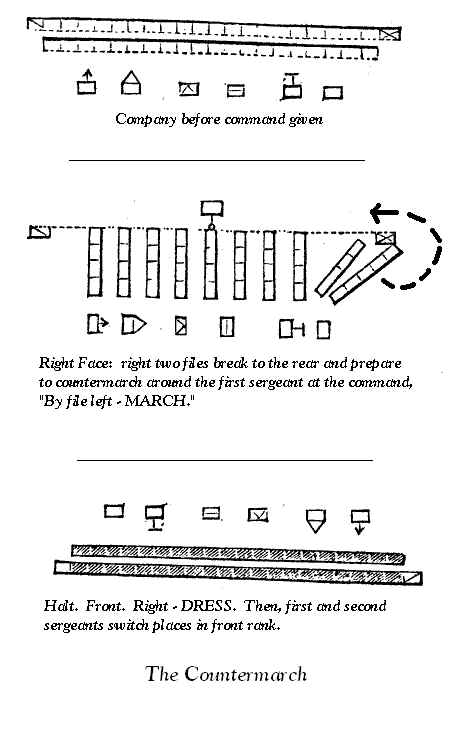
343. The company being at a halt, and supposed to constitute part of a column, right in front, when the instructor shall wish to cause it to countermarch, he will command:
1. Countermarch. 2. Company, right - FACE. 3. By file, left. 4. MARCH.
344. At the second command, the company will face to the right, the two guides to the right about; the captain will go to the right of his company and cause two files to break to the rear and then place himself by the side of the front rank man, to conduct him.
345. At the command, march, both guides will stand fast; the company will step off smartly; the first file, conducted by the captain, will wheel around the right guide, and direct its march along the front rank so as to arrive behind, and two paces from the left guide; each file will come in succession to wheel on the same ground around the right guide; the leading file having arrived at a point opposite to the left guide, the captain will command:1. Company. 2. HALT. 3. FRONT. 4. Right - DRESS.
346. The first command will be given at four paces from the point where the leading file is to rest.
347. At the second command, the company will halt.
348. At the third, it will face to the front.
349. At the fourth, the company will dress by the right; the captain will step two paces outside of the left guide, now on the right, and direct the alignment, so that the front rank may be enclosed between the two guides: the company being aligned, he will command, FRONT, and place himself before the centre of the company as if in column; the guides, passing along the front rank, will shift to their proper places, on the right and left of that rank.
(3) "Don't Show Your Backs to the Enemy, Boys!"
(A) The Backwards Retreat
During battle, troops sometimes must retreat under fire. A common command is, "backwards, MARCH," followed by the cautions of "grab the straps of the man in front" and "watch for the wounded." At a mainstream event I attended in 2006, the caution command was, "in good order" as in "retreat in good order." A private told me that meant we were ordered to march backwards.
It's all a lie. The backward march is contained in the schools of the soldier, company, and battalion, but only with this caveat: " ... the instructor will not cause more than fifteen or twenty steps to be taken in succession, and to that extent but seldom." See, H.C. 115; C.C. 115.
A company may be able to march backwards a short distance occasionally. However, a battalion never marches backwards in retreat. Here are the commands from Hardee's SoB regarding battalions in retreat:
ARTICLE FIFTH.
To march in retreat, in line of battle.664. The battalion being halted, if it be the wish of the colonel to cause it to march in retreat, he will command:
1. Face to the rear. 2. Battalion, about - FACE.
668. These dispositions being made, the colonel will command:
3. Battalion, forward.
670. The colonel will then command:
4. MARCH (or double quick - MARCH).
ARTICLE SIXTH.
To halt the battalion marching in retreat, and to face it to the front.676. The colonel having halted the battalion, and wishing to face it to the front, will command:
1. Face to the front. 2. Battalion, about - FACE.
678. The battalion marching in line of battle by the front rank, when the colonel shall wish to march it in retreat, he will command:
1. Battalion, right about. 2. MARCH.
679. At the command, march, the battalion will face to the rear and move off at the same gait by the rear rank. The principles prescribed, No. 669 and following will be carefully observed.
680. If the colonel should wish the battalion to march again by the front, he will give the same commands.
Scott's Evolutions of the Line notes that alternate battalions of a brigade may retreat in the same manner that skirmishers retreat. Although not specifically contained in the SoB, alternate retreat of companies is entirely consistent with the principles of the tactics.
(B) "Backwards right (or left) wheel, march."
Is the pivot on the right or the left? Who knows? Just do that others are doing. Actually, it's neither location. Forward wheels are found in the manual, but backward ones are not. So, why do them? It's faster and easier for a company commander to place two files on a new line and have the men dress onto that new line. As noted in the schools of the soldier and company per Hardee:
SoS 321. Alignments to the rear will be executed on the same principles, the recruits stopping back a little beyond the line, and then dressing up according to the principles prescribed No. 312, the instructor commanding:
Right (or left ) backward - DRESS.
SoC 21. Successive alignments having habituated the soldiers to dress correctly, the instructor will cause the ranks to align themselves at once, forward and backward, sometimes in a direction parallel, and sometimes in one oblique, to the original direction, giving, in each case, two or four men to serve as a basis of alignment to each rank. To effect which, he will command:
1. Right (or left)- DRESS. 2. FRONT.
or
1. Right (or left) backward- DRESS 2. FRONT.(4) Just One More Step!
It is a common misconception that all commands to halt or change direction occur on the left foot just as the command to march commences with the left foot. This is logical, but wrong.
From the halt, the left foot always precedes the right when commencing regardless of whether the direction is forward or back; however, commands to halt or to change cadence, step, or direction may occur when either foot reaches the ground. Similarly, changes of direction by the flank, file or wheel may occur upon either foot. The only marching command which specifies a particular foot upon which the command may be executed is Right About. There, the facing occurs on the left foot. Per Hardee:
SoS 344. At the command, march, which will be given at the instant the left foot is coming to the ground, the recruit will bring this [left] foot to the ground, and turning on it, will face to the rear; he will then place the right foot in the new direction, and step off with the left foot.
But see, Gilham, who wrote a cleaner and clearer method:
207. At the command, march, which should be given at the instant the right foot touches the ground, the soldier will complete the next pace with the left foot, then turning to the right about on both heels, will step off with the left foot.
(5) It Worked for Armistead!
(A) "At the double quick"
When increasing the cadence from quick time to double quick time, the command is not, "at the double quick." The proper command is the less dramatic, "double quick step - march." HS 105.
Also remember that the pieces can be carried at trail as well as right shoulder shift per HS 371: "[When at double quick time, the] instructor will cause the pieces to be carried either on the right shoulder or at a trail."
(B) Watch the Accordion Open and Close at Double Quick Time.
Reenacting companies often perform the double quick step while in two ranks. The result is a long, thin line line of reenactors which slowly increases in length. When halted, the ranks quickly close like bellows of an accordion. It looks cartoonish because it is. The ranks should be doubled when the double quick step is performed because this decreases by half the length of the column.
Neither Hardee or Casey were very clear about this issue. Per C.S. 352 and H.S.:
372. The instructor will sometimes march the squad by the flank, without doubling the files.
373. The principles of this march are the same as in two ranks, and it will always be executed in quick time."
This implies that it may not be performed at double quick time. Gilham was more specific, "The double quick, however, will never be executed without the ranks being doubled." Para. 237.
(6) "Prepare To" Get Ready to Do Something.
The commander wants to rest the men, but they are armed. The arms need to be ordered and stacked. The command is raised, "Prepare to fix bayonets" followed by "fix bayonets. Then, "Prepare to stack arms" which is followed by "stack arms." There are no such prepatory commands.
As noted in Coppee's Field Manual of the Evolutions of the Line (Lippincott & Co., 1862), the prepatory command by the commanding general for his brigade to order arms is merely, "order arms." To stack: "stack arms." Nothing is mentioned about fixing bayonets, but logic dictates a similar result. The colonels echo each of these commands individually. For example:
General: Order Arms. Colonel: Order
Arms.
General: Stack Arms. Colonel: Stack
Arms.
The same rules apply to "prepare to take arms." The command does not exist. Actually, no specific commands exist. Per Hardee's SoB:
66. The colonel wishing the men to return to the ranks, will cause attention to be sounded, at which the battalion will re-form behind the stacks of arms. The sound being finished, the colonel after causing the stacks to be broken, will command, Battalion.
67. At this command, the men will fix their attention, and remain immovable.
Scott's Evolutions of the Line contains similar language.
(7) Why Did the Company Shift?
A battalion marching by the flank can become a column of companies through several different methods. The most common is "by company into line." When the men run to the left, they align themselves upon the first sergeants (right of the company) who are the only soldiers in the battalion who do not shift automatically to the left.
The first sergeants are all found walking in the same trace on the right of the column. After the companies have formed, the second sergeants move to the left and - in theory - all walk in the same trace at the right of the column. Once the companies have settled, the battalion commander then commands, Guide left. Everyone then shifts to the left - including the first sergeants.
To be performed properly, the companies should be of equal size or the first company in line should be the largest in the battalion. A small first company with larger following companies means the following companies will be required to shift right at the battalion command, Guide left. An alternative method is for the battalion commander to set the guide for the battalion to at least two paces to the left of the largest company in the battalion.
By shifting the guide, the companies are returned to the position of "right in front, guide left" as they were when marching by the right flank and before the companies were formed into a column of companies. However, the companies should not automatically shift the guide to the left as the battalion commander may order the head of the column to the left. In so doing, the guide is on the right, not the left. The company commanders would be well advised to wait for the battalion commander to determine where the guide should be.
For more information see my article, Know Your Guides: Marching by the Flank and in a Column of Companies.
(8) Second Sergeants Belong in the Rank of File Closers, Not in the Battalion Line of Battle
Second sergeants belong on the left of their companies when the left of the company is unmasked or uncovered by a company on the left. When another company adjoins the first company, the second sergeant belongs in the rank of file closers. See, Hardee Revised, Title First, paragraphs 14 and 15.
An example of the mechanics of the second sergeant moving from the rank of file closers, to the left of the company, and back to the rank of file closers is seen when a battalion:
(1) breaks from a battle line to a column of companies with the command, "by company, right wheel", SoB, 69;
(2) as noted in para. 71, "the left guide, as soon as he can pass, will place himself on the left of the front rank to conduct the marching flank...."; and
(3) forms on the right into line of battle, para 414.
The commands for right into line complete the example:
417. 1. On the right, into line. 2. Battalion, guide right.
418. 1. Right turn. 2. MARCH.
419. 1. First company. 2. HALT.
420. At the second command, the company will halt; the files, not yet in line, will form promptly; the left guide will retire as a file closer....
(9) You Can Always Tell the Modern Soldiers
The outside man should not have to run to keep up with his file partners. When changing direction by file, the four commrades in battle perform a small wheel at the speed of the outside man. The inside men conform to his speed around the arc. When the men on the inside turn abruptly or walk at their speed, the outside man is forced to run to keep pace with the others. See, C.C. 144.

By File Left from Gilham
H.C. 142. The company being faced by the flank, and either in march, or at a halt, when the instructor shall wish to cause it to wheel by file, he will command:
1. By file, left (or right). 2. MARCH.
143. At the command march, the first file will wheel; if to the side of the front rank man, the latter will take care not to turn at once, but to describe a short arc of a circle, shortening a little the first five or six steps in order to give time to the fourth man of this file to conform himself to the movement. If the wheel be to the side of the rear rank, the front rank man will wheel in the step of twenty-eight inches, and the fourth man will conform himself to the movement by describing a short are of a circle as has been explained. Each file will come to wheel on the same ground where that which preceded it wheeled.
(10) The Mischievous Manual of Arms
Here are a slew of weird commands related to the manual of arms.
(A) 1. Front rank, KNEEL. 2. Rear rank, step - UP.
There is no such series of commands in any of the manuals. Soldiers fired in two ranks while standing. Reenactors often fire with the front rank kneeling because we, weekend warriers, lack firing discipline from a lack of regular practice and/or too many fresh fish rushed into the ranks. Kneeling does exist in the manuals, but it is contemplated for skirmishing, not company firing.
The second part of the "kneel" sequence of reenactor commands exists because the kneeling rank steps forward with the left foot. As noted in H.S. 291 and C.S. 300, the right foot goes to the rear:
300. The instructor will command:
FIRE AND LOAD KNEELING.
301. At this command, the man on the right of the squad will move forward three paces and halt; then carry the right foot to the rear and to the right of the left heel, and in a position convenient for placing the right knee upon the ground in bending the left leg; place the right knee upon the ground; lower the piece, the left fore-arm supported upon the thigh on the same side, the right hand on the small of the stock, the butt resting on the right thigh, the left hand supporting the piece near the lower band.
302. He will next move the right leg to the left around the knee, supported on the, ground, until this leg is nearly perpendicular to the direction of the left foot, and thus seat himself comfortably on the right heel.
303. Raise the piece with the right hand and support it with the left, holding it near the lower band, the left elbow resting on the left thigh near the knee; seize the hammer with the thumb, the fore-finger under the guard, cock and seize the piece at the small of the stock; bring the piece to the shoulder, aim and fire.
304. Bring the piece down as soon as it is fired, and support it with the left hand, the butt resting against the right thigh; carry the piece to the rear rising on the knee, the barrel downward, the butt resting on the ground; in this position support the piece with the left hand at the upper band, draw cartridge with the right and load the piece, ramming the ball, if necessary, with both hands.
305. When loaded bring the piece to the front with the left hand, which holds it at the upper band; seize it at the same time with the right hand at the small of the stock; turn the piece, the barrel uppermost and nearly horizontal, the left elbow resting on the left thigh; half cock, remove the old cap and prime, rise, and return to the ranks.(B) Support Is Straight; Right Shoulder Shifts
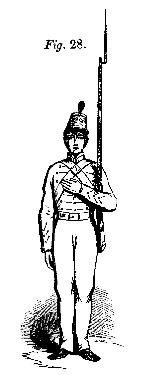
Support Arms and Right Shoulder Shift from Gilham
Ever wonder why reenactors keep their arms sloped at support but straight at right shoulder shift when the pictures in the manuals are just the opposite? The answers are found in these two articles:
Support for Support Arms by by Marc A. Hermann of the The Daybreak B'hoys; and
Right Shoulder Shift: A Reexamination by John Stillwagon of the Southern Guard Living History Ass'n; and
(C) Relax a Little, Soldier!
"In place rest" is used as a formal position where the left foot is forward, the right to the rear; the right hand clutches the musket near the upper band; and the left hand drapes over the right forearm. Although allowable as a position under this command, it's not what was intended. The only requirement is that either heel must remain on the alignment. The musket may be held in any manner. Best of all, the soldiers may speak.
Relax a little. Pivot on one of those heels and talk to your pards in the rear rank. Save the stiffness when the commander demands attention. More information about "in place rest" can be found in my article, Rest, Rest, Rest and Rest: Don't Let Established Reenacting Practices Interfere with Period Practices.
(D) Charge Bayonet like the 54th: Haaaaaaaaa!"
Great buddy movie; bad drill lesson. When receiving the command, "charge bayonet", there is no command to growl menacingly while dropping the musket into the left hand. On a battlefield, a growl is fierce and appropriate for shock tactics. On the drill field, however, it's just silly theatrics from the movies. Save the growl for intimidating the foe, not being an extra in a movie.

Charge Bayonet from Gilham
(E) Don’t Disrespect the Colonel!
So many ways to present arms to the colonel at parade. Too bad only one method is correct. Identical wordings for presenting arms exist in Hardee’s Revised 143, Casey at SoS 150 and Gilham at 145:
Present - ARMS
One time and two motions.
143. (First motion.) With the right hand bring the piece erect before the centre of the body, the rammer to the front; at the same time seize the piece with the left hand half-way between the guide sight and lower band, the thumb extended along the barrel and against the stock, the fore-arm horizontal and resting against the body, the hand as high as the elbow.
144. (Second motion.) Grasp the small of the stock with the right hand below and against the guard.
Drawings from these manuals show the key is making the left arm horizontal with and parallel to the ground, not adjusting the middle band to the height of the eye.
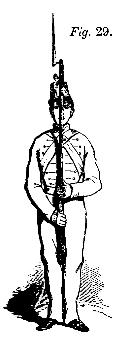
Present Arms from Gilham (1861)

Fig. 1: Present Arms and Fig. 3: Support Arms;
Both from Scott's Abstract (1830)
More articles about drill can be found by clicking on this link.
Links to several different drill manuals can be accessed from here.
Sources:
Casey, Brig. Gen. Silas, Infantry Tactics; Vols. I, II, & III, New York: D. Van Nostrand (1862)
Coppee, Capt. Henry, The Field Manual of Evolutions of the Line; Philadelphia, J.B. Lippincott & Co. (1862)
Gilham, Maj. William, Manual of Instruction for the Volunteers and Militia of the United States; Philadelphia: Charles DeSilver, Cushings & Bailey, Baltimore (1861)
Hardee, Brig. Gen. William J., Rifle and Infantry Tactics, Revised and Improved (1862)
Scott, Winfield, Infantry Tactics or Rules for the Exercise and Manoeuvers of the United States Infantry New Edition; New York; Harper and Brothers, Publishers Franklin Square (1861)
Tackitt, Silas, Guides Posts; Seattle (2004)